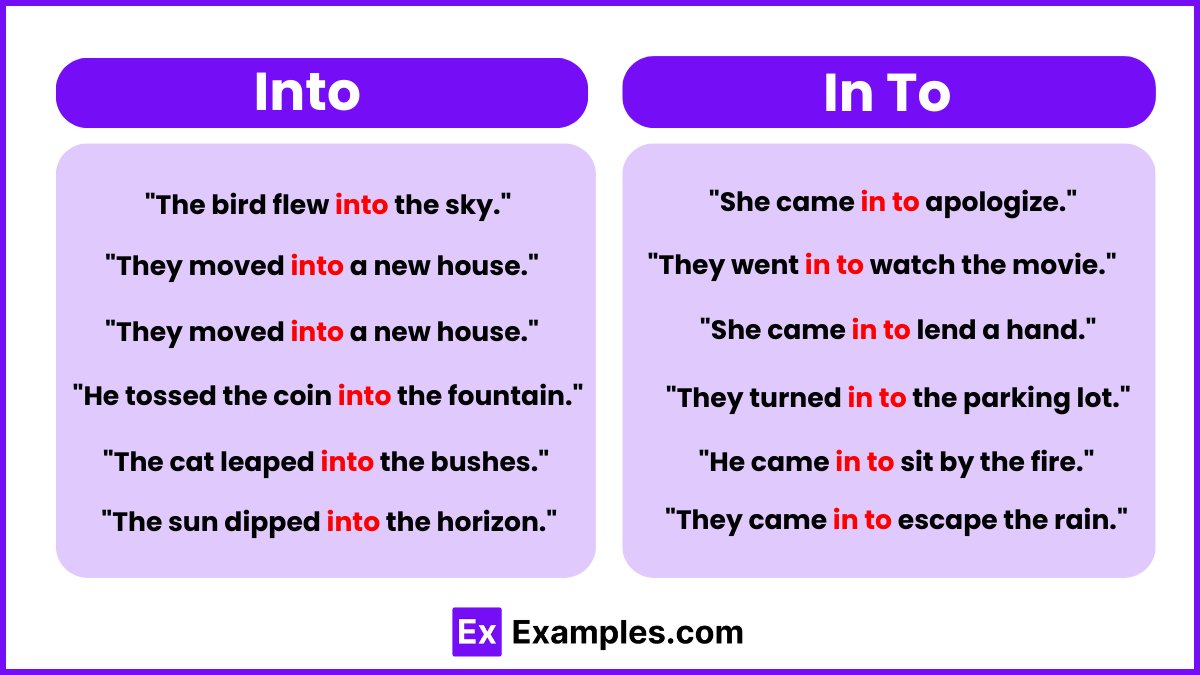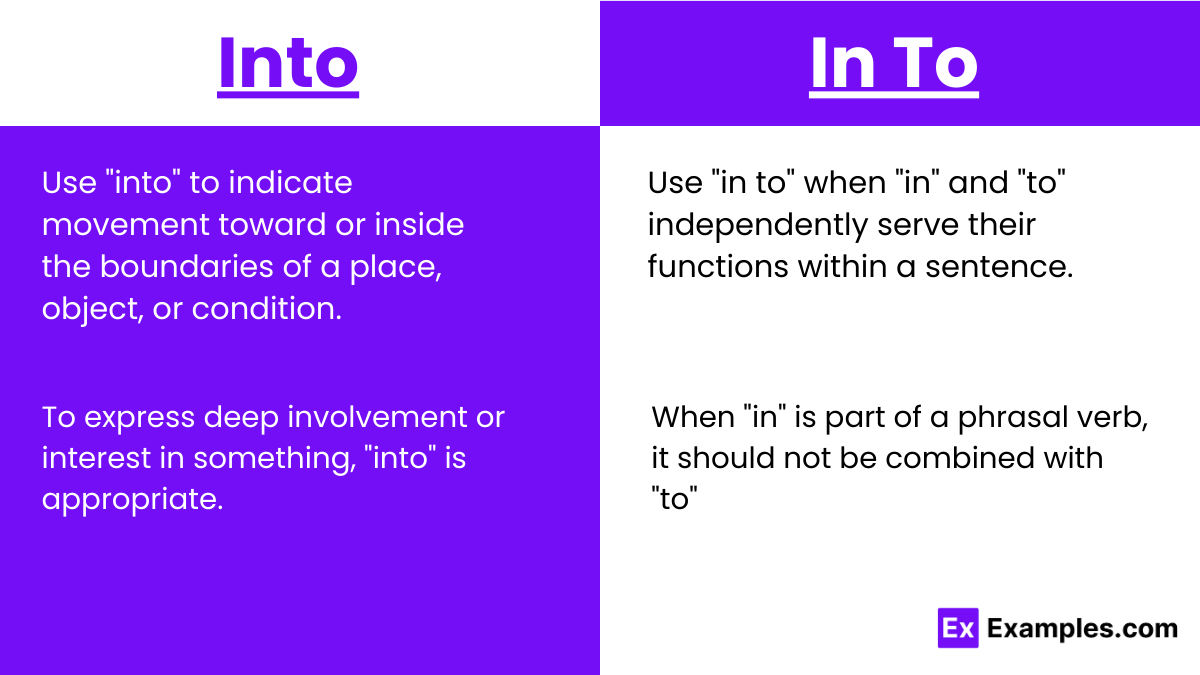Into vs In To – Examples, Differences, Usage, PDF
The subtle distinction between “into” and “in to” presents a fascinating aspect of English grammar, where pronunciation does not always reveal the underlying syntactical differences. “Into,” serving as a single preposition, paints pictures of movement, transition, and engagement, whether it’s about delving into a book, transforming into something new, or literally walking into a room. Its role is to convey a sense of unity and direction, encapsulating actions or states that involve entering, changing, or deeply engaging with another entity.
On the flip side, “in to,” though phonetically identical to “into,” consists of two separate elements that retain their individual meanings within a sentence. This pairing often occurs when “in” is part of a phrasal verb or when “to” is part of an infinitive verb phrase, each playing its part within the broader sentence structure. Understanding when to fuse these words into a single preposition and when to keep them distinct is key to mastering their correct usage, ensuring clarity and precision in written communication, especially for students honing their linguistic skills.
Into and In To – Meaning
Into: “Into” is a preposition that conveys movement or transformation, indicating direction towards the inside of a place or thing. It is used to express a change in state, such as turning one thing into another, or to denote immersion or involvement in a particular activity or interest. “Into” implies entry, both in a literal sense, like walking into a room, and in a figurative sense, like getting into trouble. It represents a transition from one condition to another, emphasizing penetration, absorption, or conversion.
In To: “In to,” though sounding identical to “into,” comprises two separate parts: the preposition “in” and the adverb “to.” This combination is used when “in” is part of a phrasal verb or when “to” is part of an infinitive verb phrase, and the meanings of “in” and “to” need to be maintained distinctly within the context. For example, in “hand in to the teacher,” “in” is linked with “hand” forming the phrasal verb “hand in,” and “to the teacher” indicates the recipient of the action.
Summary
“Into” and “in to” serve distinct functions in English grammar. “Into” is used to express movement towards the inside of something, action leading to a new state, or a transformation. It suggests a motion or change from one condition to another. On the other hand, “in to,” though less frequently encountered as a combined unit, typically appears in contexts where “in” concludes a phrasal verb and “to” begins an infinitive, often conveying a purpose or intention. When “in” and “to” are used adjacent to each other but pertain to different parts of a sentence, they remain separate, preserving their individual meanings.
Difference Between Into and In To
The distinction between “into” and “in to” in English grammar hinges on their differing roles and meanings within a sentence. “Into” is a preposition that signifies movement towards or inside something and can also indicate a change in state or transformation. In contrast, “in to” involves the separate use of “in” and “to” where “in” typically ends a phrasal verb and “to” starts an infinitive verb phrase, each retaining its specific function. Understanding these differences is crucial for precise and clear expression in writing. Below is a table highlighting key distinctions:
| Aspect | Into | In To |
|---|---|---|
| Function | Preposition | Combination of preposition “in” and adverb “to” |
| Usage | Indicates movement towards/inside | Used when “in” is part of a phrasal verb and “to” starts an infinitive |
| Meaning | Entry, immersion, transformation | “In” concludes a verb phrase; “to” introduces purpose or direction |
| Example Context | Entering a place, becoming part of something | Completing an action, intending to do something |
| Transformation | Implies change or transition | Does not imply change but rather intention or direction |
| Direction | Towards the inside or deeper into something | Direction is not implied; focuses on action and intent |
| Phrasal Verbs | Not associated with phrasal verbs | Often follows a phrasal verb |
| Infinitive Verbs | Does not introduce infinitives | “To” may introduce an infinitive verb |
| Literal vs. Figurative | Can be used both literally and figuratively | Primarily used in a literal sense |
| Commonality | More commonly used | Less commonly used, more specific contexts |
Examples of Into and In To
Through these examples, the nuanced difference between “into” and “in to” becomes apparent, highlighting the importance of context in their application for clear and effective communication. Here are examples to illustrate the correct usage of “into” and “in to,” shedding light on their distinct roles in language:
Examples of “Into”
- She walked into the room quietly.
- The caterpillar transformed into a butterfly.
- He got into trouble for being late.
- They turned the study into a nursery.
- She’s really into jazz music.
Examples of “In To”
- Please come in to sign the documents.
- He stopped by in to say hello.
- She went back in to retrieve her phone.
- Drop in to see our new office anytime.
- I’ll call in to check on the delivery status.
When to Use Into and In To
Understanding when to use “into” and “in to” is crucial for clear and precise communication in English. Here’s a guideline to help distinguish between the two:
When to Use “Into”
- Movement or Direction: Use “into” to indicate movement toward or inside the boundaries of a place, object, or condition. Example: “She walked into the house.”
- Transformation: When something changes form or state, use “into”. Example: “The magician turned the handkerchief into a dove.”
- Engagement or Interest: To express deep involvement or interest in something, “into” is appropriate. Example: “He’s really into classical music.”
When to Use “In To”
- Phrasal Verbs: When “in” is part of a phrasal verb (a verb that is made up of a main verb together with an adverb or a preposition, or both), it should not be combined with “to”. Example: “I came in to warm up.”
- Separate Functions: Use “in to” when “in” and “to” independently serve their functions within a sentence, such as “in” concluding a verb phrase and “to” starting an infinitive verb phrase. Example: “He turned in to go to bed.”
By recognizing the specific contexts and meanings associated with “into” and “in to”, you can choose the appropriate form to express movement, transformation, engagement, or the separate functions of “in” and “to” in your writing and speech.
Exercises on “Into” and “In To”
- He walked ______ the room and set his keys on the table.
- Please come ______ the office to discuss your report.
- The caterpillar turned ______ a beautiful butterfly in the spring.
- She went back ______ the house because she forgot her phone.
- They decided to venture ______ the cave despite the warnings.
- Could you drop these files off ______ my desk when you have a moment?
- The children jumped ______ the pile of leaves with joy.
- He had to log ______ the system to update the software.
- The movie delves deep ______ the complexities of human emotions.
- She always tunes ______ her favorite radio station on the way to work.
FAQs
Is It Tuning Into or Tuning In To?
The correct form is “tuning in to.” This phrase combines the phrasal verb “tuning in” (meaning to adjust a receiver to a certain frequency or listen attentively) with “to” introducing the object or activity. For example, “tuning in to your favorite radio station.”
Where Do We Use In and Into?
Use “in” to indicate a static position within boundaries, and “into” to express movement from outside to inside something. “In” shows location, while “into” emphasizes a change of position, implying a transition or transformation. For example, “She is in the room” vs. “She walked into the room.”
Is It Plugged In To or Into?
The correct form is “plugged into.” This phrase indicates the action of inserting a plug for an electrical device into a socket, emphasizing the motion or action of connecting something. For instance, “The lamp is plugged into the outlet.”





